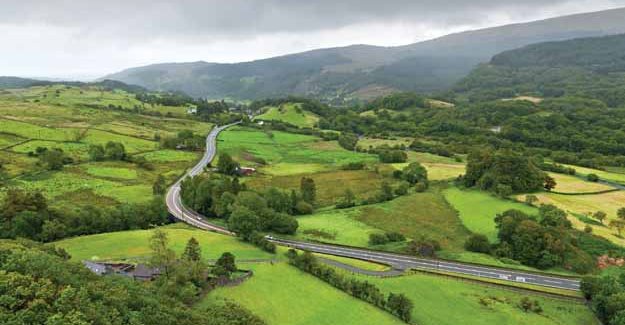Mobile phone coverage across the GB road network
Almost 4,600 miles of British roads have no 2G mobile phone coverage from any network provider meaning drivers couldn’t call for help in the case of a breakdown, accident or emergency.
The stretches of road – measuring 4,561 miles in total – represent 2% of the length of Britain’s road network and are to be found in 49 separate local authority areas. Those local authority areas with the most miles of road without any mobile signal coverage are:
1) Highland (452 miles of road with no coverage)
2) Powys (437 miles)
3) Argyll & Bute (293 miles)
4) Cumbria (252 miles)
5) Devon (243 miles)
6) Dumfries & Galloway (237 miles)
7) North Yorkshire (231 miles)
8) Scottish Borders (226 miles)
9) Gwynedd (172 miles)
10) Ceredigion (156 miles)
Amongst the roads which have stretches with no mobile phone signal coverage at all are the A93 in Scotland, A149 in East Anglia, A494 in Wales and A591 in Cumbria.
A further 28,975 miles of road (12%) have only partial 2G coverage meaning there are many areas where some but not all phones will receive a signal depending on the service provider.
A 2G signal is the minimum needed to make phone calls and send text messages.
The research by the RAC Foundation also found that there are 14,554 miles of road (6%) where there is a complete absence of 3G coverage.
An additional 111,679 miles of road (45%) have only partial 3G coverage.
A 3G signal is needed to use smart phones effectively.
When it comes to 4G signals more than half (56%) of the road network has no coverage and more than a quarter (27%) has only partial coverage.
|
Miles (%) of road in Britain with… |
|||
|
Full network coverage |
Partial network coverage | No network coverage | |
| 2G |
211,753 (86%) |
28,975 (12%) |
4,561 (2%) |
| 3G |
119,057 (48%) |
111,679 (45%) |
14,554 (6%) |
| 4G |
43,070 (18%) |
65,950 (27%) |
136,271 (56%) |
Note: percentages might not add up to 100% because of rounding. Partial network coverage means that at least one of the four network providers – Vodafone, O2, EE, Three – will offer a signal.
If a mobile phone user is in a location where his/her mobile phone network provides no coverage but another network does (a partial not-spot) then an emergency call can be made from that phone. If there is no network coverage from any of the four providers (a total not-spot) then not even an emergency call can be made.
The RAC Foundation based its analysis on official Ofcom data. According to Ofcom, 93% of UK adults own/use a mobile phone and 66% of UK adults have a smartphone.
Steve Gooding, director of the RAC Foundation, said:
“Most of us like to think we are always just a mobile phone call away from help but even in a crowded, high-tech country like Britain the reality is somewhat different.
“Our work shows there are thousands of miles of road along which you would not want to break down or have an accident because calling the RAC, the emergency services or even home wouldn’t be an option. Even where there is partial network coverage it might not be from your network provider.
“And it’s not just in emergencies that we rely on our mobiles. Increasingly we drivers depend on our smart phones for everything from telling us how to get from A to B, to what the weather is going be, to where the congestion is.
“Yet both 3G and 4G coverage is still patchy in many areas and the chance of downloading data when we need it can often be slim.
“The concepts of connected cars and drivers is at the heart of much thinking about how we might make our travelling lives easier. But the best ideas in the world will fall at the first hurdle if there are no bars on the phone.”
ENDS
Contact:
Philip Gomm – Head of External Communications – RAC Foundation
[email protected] | 020 7747 3445 | 07711 776448 | 020 7389 0601 (ISDN)
Notes to editors:
The RAC Foundation is a transport policy and research organisation that explores the economic, mobility, safety and environmental issues relating to roads and their users.
The Foundation publishes independent and authoritative research with which it promotes informed debate and advocates policy in the interest of the responsible motorist. All the Foundation’s work is available at: www.racfoundation.org
The Ofcom website has the following definitions for different types of mobile signal:
2G The second generation of mobile telephony systems, 2G coverage is suitable for making calls and sending text messages.
3G The third generation of mobile systems, 3G enables you to watch videos and TV and access the internet through your mobile phone.
4G Fourth generation of mobile systems. Provides even faster data download and upload speeds on mobile networks.
This is a full list of 2G, 3G and 4G coverage by local authority area:



